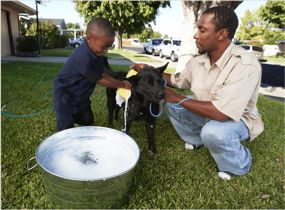Teaching Multi-Step Skills Through Task Analysis for Autistic Students
Life is filled with constant multi-step directions and processes. That’s why a common elementary project is to have students write exact directions to make a peanut butter and jelly sandwich. Their peers are then told to only do exactly what the directions say. As you might imagine, hilarity ensues—inevitably some steps are missing, like “Open the jelly jar” or “Spread the peanut butter evenly across (one or both slices) of bread.” Peers will stare confusedly at jars or pile massive amounts of peanut butter on the bread just to make a point when detailed steps are left out. What students may not realize is, this assignment is actually a task analysis in the making.
What is it?
Task analysis (TA) is the process of taking a complex skill such as making a sandwich, running the dishwasher, or doing laundry—and breaking it down into smaller, manageable, and observable steps.
Why is it useful?
If a student is struggling to complete a skill in its entirety, breaking the task down into steps can make it more apparent to teachers or parents as to where the error is occurring. Then we can use prompting, reinforcement, and/or modeling to help fill the gaps.
Autistic students particularly struggle with executive functions that govern the ability to plan and organize thoughts, recall and remember information, and initiate an activity. Listing manageable steps can be a quick reference as they learn new skills through repetition and muscle memory.
When should I use task analysis?
Task analysis should be used to chain-link together a sequence of smaller steps to perform a bigger action. Many functional, self-help, or vocational skills fit this description—rather than simply opening a microwave, the act of cooking a packet of oatmeal is comprised of multiple small steps to complete the greater action.
Here are some ideas for skills that task analysis could be helpful in breaking down:
- Laundry
- Doing dishes
- Vacuuming
- Setting the table
- Logging on to a device
- Cooking a meal
- Tying shoes
- Using the bathroom
 But is it only for life skills? Absolutely not! Task analysis can also be tremendously helpful in breaking down academic and social skills that have set steps such as long division, multi-digit multiplication, and turn-taking during a board game, or kickball.
But is it only for life skills? Absolutely not! Task analysis can also be tremendously helpful in breaking down academic and social skills that have set steps such as long division, multi-digit multiplication, and turn-taking during a board game, or kickball.
TA can also be a great way to introduce simple play scripts for anyone learning how to appropriately use play materials. Sample ideas could include:
- Feeding a baby doll
- Playing dress up
- Building a train track
- Playing restaurant
- Making sandcastles
- Building block patterns
How to implement it?
1. Choose a specific skill to target
To identify the skill you will teach, start by identifying the student’s needs and the team’s goals for them. Depending on age or developmental level, the necessity or desire of the individual to learn the skill (such as toilet training) may be an important factor in prioritizing where to start.
2. Assess the learner’s ability level and necessary materials or supports
Begin by collecting baseline data on the student’s ability to complete the identified skill. If you were going to teach them how to cook something in the microwave but they cannot accurately match numbers on a recipe to the microwave, then you may need to start with preliminary instruction before you’re ready to begin teaching the broader skill of cooking.
Similarly, if the need is high for an individual to learn a skill and they can perform each step, but they lack motivation, you may need to evaluate how to provide ample reinforcement when going through the TA.
3. Break down the skill
As described earlier in the peanut butter sandwich challenge, breaking down a skill into smaller steps can be harder than you’d expect. The best way to segment the information is by actually completing these steps or observing someone else doing so, and analyzing the process as it occurs. Here are a few different breakdowns of steps to provide some ideas of what the process can look like:
Task Analysis for PB&J Sandwich
Strategies |
Skills Required |
|
Get ingredients:
|
Knowledge of ingredients and location |
| Open up the bread bag and take out 2 slices of bread |
Untwisting a twisted tie Counting two objects |
| Place the slices side-by-side on the plate | Knowledge of "side-by-side" |
|
Open up the peanut butter jar |
Ability to twist off a lid |
| Put the knife in the jar and while still holding the knife, with the other end, get out about 2 Tbsp of peanut butter |
How to use a knife Knowledge of the quantity of Tbsp |
| With the knife, smear the peanut butter on one large side of the bread -- not on the crust, and use all the peanut butter that is left on the knife |
How to smear with a knife Knowledge of the concept of "large" Knowledge of the definition of "bread crust" |
| Open up the jelly jar | Ability to twist off a lid |
| Put the knife in the jar and get out about 2 Tbsp of jelly |
How to use a knife Knowledge of the quantity of Tbsp |
| With the knife, smear the jelly on top of the peanut butter that is on the bread |
How to use a knife Knowledge of the concept of "top" |
| Place the plain piece of bread on top of the one with the peanut butter on it |
Knowledge of the definition of "plain" Knowledge of the concept of "top" |
And of course, after eating the PB&J, you may need to consider brushing your teeth!
TASK ANALYSIS EXAMPLE: Brushing Teeth (Mason et al., 1990)
- Obtains materials
- Takes cap off toothpaste
- Puts paste on the toothbrush
- Replaces toothpaste cap
- Wets brush (I know—debatable for when to wet the toothbrush!!!)
- Brushes left outer surfaces
- Brushes front outer surfaces
- Brushes right outer surfaces
- Brushes lower right chewing surfaces
- Brushes lower left chewing surfaces
- Brushes upper left chewing surfaces
- Brushes upper right chewing surfaces
- Brushes upper right inside surfaces
- Brushes upper front inside surfaces
- Brushes upper left inside surfaces
- Brushes lower left inside surfaces
- Brushes lower front inside surfaces
- Brushes lower right inside surfaces
- Rinses toothbrush
- Wipes mouth and hands
- Returns materials
Of course, when writing a task analysis, there’s room for flexibility. I personally wet my toothbrush before I put the toothpaste on, and I definitely put peanut butter on both pieces of my bread when I make a sandwich, so I may write my version a bit differently—that’s where personalization comes into play.
4. Determine the comprehensiveness of task analysis
The best way to make sure you’ve developed a comprehensive TA is to have someone else run the steps exactly as you’ve written them. Then you’ll see if anything has been left out and revise the steps as needed.
5. Develop a teaching plan
Depending on the complexity of the skill and the student’s baseline data, the teacher should determine the best way to teach it—can the learner manage the TA in its entirety, should some of the steps be taught in phases or using forward or backward chaining? For students who are very reinforced by the end product (for example: cooking), start with the last several steps (backward chaining) and end with the positive experience of how to get there.
Similarly, the way in which the TA is presented should take into account the student’s learning style and ability. Some may need pictures of each step, some readers may have the steps written out and still others may benefit from a video model of the task before they complete it. Steps should be subtle but thorough and efficient in communicating the process to the learner.
6. Implement and monitor progress
When collecting data for task analysis, a checklist for each step can pinpoint discrete steps that may be difficult for the student—isolating those independent skills lets the teacher practice any step in isolation (when possible or applicable). Further, the checklist should include a section that outlines the level of prompting a student requires to complete the skill. Since the goal is always for students to be as independent as possible, this will help guide future instruction, too.
So whether you’re making a sandwich, washing your car, editing a paper, cooking dinner, or taking a shower, life is filled with many discrete steps that make up a larger action. Finding a way to effectively break those steps down and instruct the gaps can help students gain valuable skills, a greater quality of life, and self-reliance.
What other tips and tricks have been effective in using task analysis in your practice? Are there any specific skills that you’d like help breaking down?
For more specific information on Task Analysis see:
References:
https://autismpdc.fpg.unc.edu/sites/autismpdc.fpg.unc.edu/files/TaskAnalyis_Steps_0.pdf

Frankie Kietzman, Ed.S.
Frankie Kietzman is a Sales Development Associate for STAGES Learning with experience teaching as an elementary teacher, self-contained autism teacher for elementary and secondary students, autism specialist and coach for teachers dealing with challenging behaviors. Frankie’s passion for supporting children and adults with autism originates from growing up with her brother who is deaf and has autism. As one of her brother’s legal guardians, she continues to learn about post-graduate opportunities and outcomes for people with autism. Frankie has a Bachelor’s degree from Kansas State University in Elementary Education, a Master’s degree in high and low incidence disabilities from Pittsburg State University and in 2021, completed another Master’s degree in Advanced Leadership in Special Education from Pittsburg State University.







